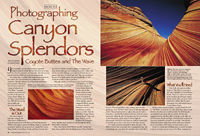Money-Making Photo Ideas
Some ways to help offset the cost of your favorite pastime
There are lots of way to make money in photography, including selling and trading photo gear, processing film and making prints for other photographers, scanning images (slides, negatives and prints) and putting them on CDs for others, retouching photos, copying and restoring old photos, collecting collectible photographs and photo books, and shooting ID photos. But none of these is particularly satisfying from a creative standpoint. Most photographers would prefer to make money by shooting pictures. So here are some money-making ideas that involve shooting pictures.
 1. Practice Makes Perfect
1. Practice Makes Perfect
If you want people to pay for your photos, those photos had better be good. And as they say, practice makes perfect. You get good at shooting photos by shooting lots of photos. But that can get expensive. You might consider getting a 4-megapixel consumer digital camera as a practice tool. It's relatively cheap these days, produces good enough image quality to publish a photo up to 7.6x5.7 inches at 300dpi and turn out good 11x17-inch inkjet prints, but mainly it's a great money-saver and learning tool. Because you don't have to buy film or pay for processing, and can archive more than 250 images on a $1 CD, you can shoot lots of photos to perfect your technique and eye. At first, you'll wind up shooting lots of "duds," because you'll shoot things you wouldn't if you had to pay for film, but before long, because you're out there shooting a lot, you'll start getting a higher percentage of "keepers" than you ever did with film. More important, as you shoot more you'll develop your eye, and your own "style." Photo by Mike Stensvold
 2. Keep Your Eyes Open
2. Keep Your Eyes Open
Newsworthy events happen every day somewhere, and just about everywhere at one time or another. Local and national pro photojournalists can't be everywhere. So there is an opportunity to take and sell good photos of breaking events. Keep your eyes open for them. But don't endanger yourself or others, or interfere with fire and police people doing their jobs. While being there to cover a breaking event is partly a matter of luck, you can also do photo features on interesting people, places and events that occur in your area.Take photos that help tell your story, keeping in mind good compositional concepts. With breaking news, you have to shoot when and where it's happening, but with features, you can often choose a photogenic time and place. Photo by Ron Leach
 3. A Picture Is Worth . . .
3. A Picture Is Worth . . .
With hundreds of publications produced every month, the vast majority using photos, there's a big opportunity for the photographer who can turn out a decent article to accompany his or her photos. It's often easier to sell a photo/text feature than individual photos to these publications (Photographic rarely buys individual photos, but often buys how-to articles from free-lancers). Don't be discouraged if you don't have a degree in English—most magazines have pro editors who can polish your prose if the photos and ideas are good. But you should be able to put your ideas down on paper clearly. Or you could consider teaming up with a writer and splitting the article fee. Photos by Lynne Eodice
 4. Off the Wall
4. Off the Wall
We've seen photos on display on the walls of many local restaurants and other businesses, and inquiries revealed that in many cases, no money changed hands: the win-win deal is that the business gets free decor, while the photographer gets free exposure. Generally, the photographer's card or contact info is attached to each print on display, and many of these photographers sell prints to customers who see them in these venues. So gather together some good prints of your work, mount them, and approach managers of such local businesses. A side benefit is it's cool to go out to dinner with friends and have them notice that your photos are hanging on the walls! Photo by Ron Leach
 5. Play the "Stock" Market
5. Play the "Stock" Market
If you like doing certain types of photography, consider the stock-photography market. Stock photos are generic pictures that are sold (licensed) to advertisers and publishers for a variety of commercial uses, including brochures, magazines, annual reports and advertising campaigns. While some photographers sell such photos themselves, most are sold through stock agencies that promote and sell the photos for you (generally taking a fee of 50% or thereabouts for their services). A single photo can generate a goodly fee total through multiple sales, but for most, stock is a way to supplement income, not the primary source. Popular stock-photo subjects include people at work or play, high-tech images, travel, scenic and industrial scenes, and transportation. Be sure to get model releases from any people who appear in these photos, because stock photos are sold for many uses, and you don't want to get sued (stock agencies generally require releases for all identifiable people in photos they handle). Picture Archive Council of America (PACA) at www.pacaoffice.org can provide a list of legitimate stock agencies. Photo by Lynne Eodice
 6. Pet Portraits
6. Pet Portraits
Lots of people have pets, and most would love to have a nice photo or two of their beloved critter. Before you hire yourself out, though, practice with your own (or a friend's) pet—when people are paying money for photos, they want good ones. Some tips: As with photos of kids, pet portraits work best when shot from the pet's eye level (don't shoot down on the pet from human eye level, unless you want that "look"). Don't use a wide-angle lens at close range unless you want an elongated, distorted look. If you use flash, move the unit off-camera to avoid red-eye. Enlist the pet's owner as an assistant to help manage the subject. And get some shots of the pet with the owner. Photo by Lynne Eodice
 7. Lead a Photo Workshop or Field Trip
7. Lead a Photo Workshop or Field Trip
Photo workshops and field trips are very popular, and quite a few photographers supplement their incomes conducting them. If you're an expert on a specific type of photography or location, you might consider conducting photo workshops or field trips to give others the benefit of your knowledge and experience—and make some money along the way. You can cover the costs of your photo travels this way. This is not an endeavor for loners—be ready to answer lots of questions, and remember that when you lead a photo field trip, you're responsible for a group of people, not just yourself. A benefit is that you can shoot, too, on the expeditions you lead—it's a way to make photo trips you couldn't otherwise afford. Photo by Jim Zuckerman
- Log in or register to post comments











































